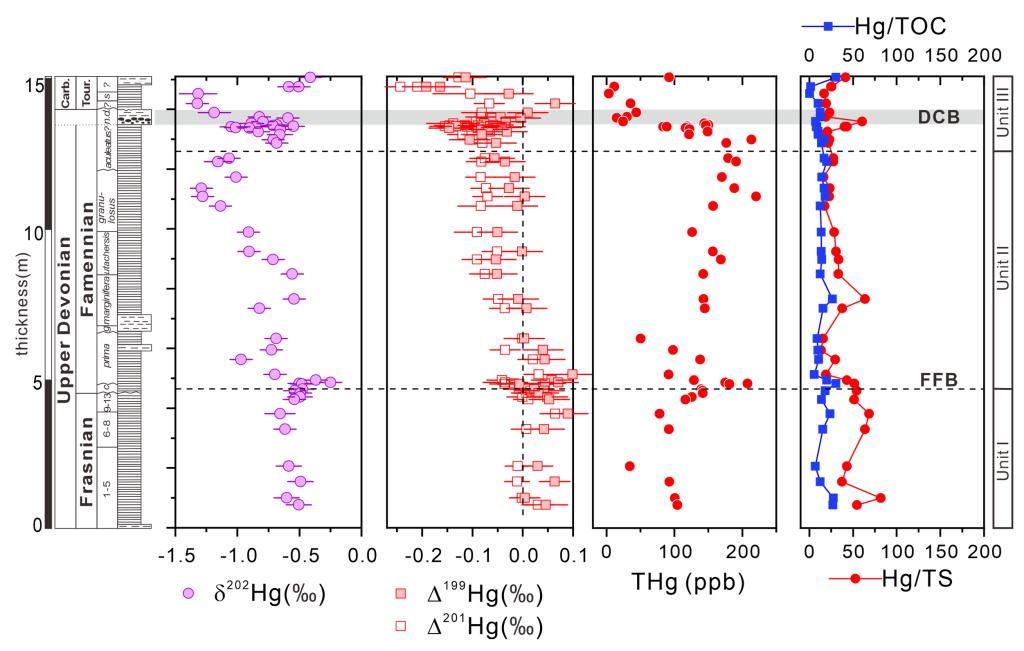The redox condition of the ocean is a crucial factor in biological evolution. Marine anoxia/euxinia often serves as a direct cause of mass extinctions and a limiting factor for ecosystem recovery following extinction events. The photic zone, which is the key zone for marine photosynthesis and biological survival, plays a critical role. Therefore, the phenomenon of photic zone euxinia (PZE), characterized by the enrichment of toxic H2S in the photic zone, is considered a key kill mechanism of multiple mass extinctions in the Phanerozoic Eon. In the modern ocean, global warming and anthropogenic pollution have led to a decrease in dissolved oxygen and the expansion of sulfidic waters, posing a significant threat to Earth's habitability. Accurate reconstruction of PZE is therefore crucial for understanding the coevolution of the environment and life.
Mercury isotopes have emerged as a new indicator for PZE. Mercury isotopes are highly sensitive to the photochemical processes in the marine photic zone and the redox processes at the air-water interface, making them uniquely advantageous for indicating the redox state of the marine photic zone. Professor Wang Zheng from the School of Earth System Science at Tianjin University discovered in previous research that black shales deposited under PZE conditions during the Mesoproterozoic Era exhibited significant negative mass-independent fractionation (MIF) and synchronous positive mass-dependent fractionation (MDF) of Hg isotopes, consistent with changes in traditional biomarker-based indicators of PZE. This finding first proposed the indicative role of Hg isotopes in PZE, laying the foundation for the application of Hg isotopes in reconstructing the paleo-redox state of ancient oceans (Zheng et al., PNAS, 2018).
Recently, the Center of Advanced Science of Isotope (CASI) at Tianjin University and George Mason University in the United States collaborated to use Hg isotopes to reconstruct the PZE in the Late Devonian and evaluate their impact on the Late Devonian mass extinction (LDME). The mechanism of LDME is a puzzle among the "Big Five" mass extinction events in the Phanerozoic Eon, and current studies generally attribute it to large-scale volcanic activity and marine anoxia/euxinia. In this study, high-resolution measurements of Hg content and Hg isotopes in the Chattanooga Shale of the Illinois Basin in North America were conducted (Figure 1), leading to the following main findings:

Figure 1. High-resolution measurements of Hg content and Hg isotopes in the Chattanooga Shale of the Illinois Basin in North America
1) No anomalous Hg enrichment was observed near the boundaries of the two major extinction events (FFB and DCB) in the Late Devonian. This result is consistent with previous studies on Hg concentrations in other basins in North America and South China, indicating that Late Devonian volcanic activity did not cause a global-scale Hg anomaly and its environmental impact was likely regional. Thus, large-scale volcanic activity is unlikely to be the primary cause of the LDME.
2) Importantly, significant negative MIF excursion (reaching -0.24‰) and synchronous positive MDF excursion peaks were observed near the extinction boundaries of FFB and DCB, which closely resemble the Hg isotope drift pattern associated with PZE during the Mesoproterozoic Era. This indicates the presence of PZE during both extinction events. In particular, multiple Hg isotope excursions were observed around the DCB, with greater magnitude than that around the FFB, suggesting the occurrence of more intense and recurrent PZE during the DCB.
3) Between the FFB and DCB, a long-term progressive, synchronous negative drift of both MIF and MDF was observed, consistent with the isotopic characteristics of terrestrial vegetation. Therefore, Hg isotopes also provide new evidence for the expansion of terrestrial vegetation during the Late Devonian period. The expansion of terrestrial vegetation enhanced continental weathering and the input of nutrients into the ocean, leading to marine eutrophication. This may have been the cause of the recurrent PZE during the DCB.
The above findings based on Hg isotopes reveal the relationships among major environmental events (volcanic activity, expansion of terrestrial vegetation, and photic zone euxinia) during the Late Devonian period (Figure 2), and provide new evidence for the impact of PZE on the LDME and further demonstrate the enormous potential of Hg isotopes in reconstructing paleoenvironmental evolution.

Figure 2. The relationships among major environmental events during the Late Devonian and the corresponding variations of Hg isotopes.
This study was recently published in the internationally renowned top geoscience journal "Earth and Planetary Science Letters," with Professor Wang Zheng from Tianjin University as the first author, and Professor Jiubin Chen and Professor Geoffrey J. Gilleaudeau from George Mason University as the co-corresponding authors. The research was jointly funded by the National Natural Science Foundation of China (41973009, 41625012), the U.S. National Science Foundation (EAR 1760203), and the NASA Postdoctoral Program. In addition, a closely related study, which is recently published in “Communications Earth & Environments,” provides further insights into the research discussed above (see “Related research” below).
Citation of this research:
Zheng W. (郑旺), Gilleaudeau G. J.*, Algeo T. J., Zhao Y. (赵亚秋), Song Y. (宋宜), Zhang Y. (张元明), Sahoo S. K., Anbar A. D., Carmichael S. K., Xie S. (谢树成), Liu C.-Q. (刘丛强) and Chen J. (陈玖斌)* (2023) Mercury isotope evidence for recurrent photic-zone euxinia triggered by enhanced terrestrial nutrient inputs during the Late Devonian mass extinction. Earth Planet. Sci. Lett. 613, 118175. https://www.sciencedirect.com/science/article/pii/S0012821X23001887
Related research:
Sun R.(孙若愚), Liu Y. (刘羿), Sonke J. E., Feifei Z.(张飞飞), Zhao Y.(赵亚秋), Zhang Y.(张永根), Chen J.(陈玖斌), Liu C.-Q.(刘丛强), Shen S.Z.(沈树忠), Anbar A. D. and Zheng W.*(郑旺) (2023) Mercury isotope evidence for marine photic zone euxinia across the end-Permian mass extinction. Commun. Earth Environ. 4, 1–11. https://www.nature.com/articles/s43247-023-00821-6
Reference:
Zheng W. (郑旺)*, Gilleaudeau G. J., Kah L. C. and Anbar A. D. (2018) Mercury isotope signatures record photic zone euxinia in the Mesoproterozoic ocean. Proc. Natl. Acad. Sci. U.S.A. 115, 10594–10599.